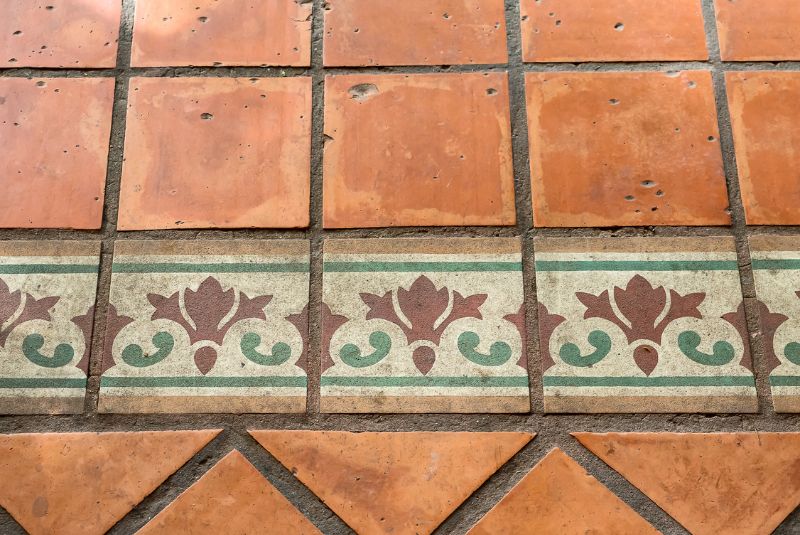Exploring the Diversity of Terracotta Tiles: An In-Depth Look at Types, Applications, and Maintenance
Terracotta tiles, one of the oldest forms of ceramic tiles, offer a wide array of choices that can be overwhelming.
Derived from the Italian term “baked earth,” terracotta boasts a porous, easily shaped clay rich in iron, resulting in its distinctive reddish-brown hue.
Fired at a relatively low temperature (around 1,000 degrees Fahrenheit), terracotta maintains its porosity unless glazed.
This makes terracotta readily accessible and more cost-effective than many other ceramic options.
Its popularity lies in the captivating natural colors that epitomize earthy tones.
For those considering terracotta flooring, discerning the nuances among its various types is essential.
Types of Terracotta Tiles
Low-Density vs. High-Density Tiles
Terracotta tiles are often categorized as high-density or low-density, although manufacturers often emphasize the “high density” label.
Additionally, they are distinguished by their thickness, with high-density tiles being thicker and more crack-resistant, making them suitable for high-traffic areas.
Conversely, low-density terracotta, thinner and more porous, is not recommended for wet zones or stain-prone areas like kitchens and bathrooms.
Color Variations
Terracotta’s natural color variations are influenced by the clay’s source.
Ranging from yellow to dark brown, with numerous reddish hues in between, these colors define terracotta tiles.
Saltillo terracotta, originating from Saltillo, Coahuila, Mexico, is characterized by its blend of yellow and reddish tones.
Other varieties include antique Saltillo, manganese, and Spanish mission red.
Natural, Burnished, or Sealed Tiles
In its natural state, terracotta’s colors wash across tiles in enchanting, unique patterns, creating distinct yet understated visuals.
However, this porous nature makes unglazed terracotta susceptible to water and liquid penetration, potentially leading to mold and stains.
To counter this, natural terracotta is often treated with sealants.
Alternatively, surface burnishing during manufacturing reduces absorbency, creating a denser, smoother finish.
Glazed vs. Unglazed
Glazing, a process of applying a glass-like surface finish during a second firing, distinguishes glazed terracotta with its glossy appearance.
It also imparts waterproofing, making it stain-resistant. However, glazed terracotta conceals the tile’s natural colors.
Hand-glazed or hand-painted terracotta tiles offer a compromise, preserving some of the natural beauty while enhancing resistance to stains and water.
When using glazed terracotta, especially in wet areas like kitchens and bathrooms, ensure they are non-slip.
Machine-Cut vs. Handmade Terracotta Tiles
Choosing between machine-cut and handmade terracotta tiles is a significant decision.
Machine-cut tiles exhibit uniform size and shape, ensuring consistency in the final installation.
These tiles maintain the iron-laced clay’s natural beauty while being more consistent in dimension, simplifying installation.
Handmade terracotta, an artisanal craft found in regions like Mexico and southern Europe, embraces imprecise cuts and slight irregularities, enhancing the material’s rustic charm.
However, this craftsmanship is time-consuming and can result in unpredictable sizes, complicating installation.
Applications for Terracotta Tile Flooring
Terracotta’s rustic allure makes it an ideal flooring material, creating a rugged yet subdued ambiance.
It harmonizes seamlessly with Mexican, Mediterranean, or Southwest decors and complements rustic or natural settings.
Its warmth, surpassing stone or glazed ceramic, suits earth-tone decor and log cabin styles.
While terracotta can be used in some outdoor applications, it’s suitable only for climates without regular freezing temperatures.
Terracotta Tile Maintenance and Care
Terracotta flooring necessitates sealants, available in topical polymer with satin or glossy finishes or impregnating seals.
Regular cleaning involves vacuuming and damp-mopping with mild soap and water.
Stains can be removed using a mixture of oxalic acid and water.
Avoid acidic cleaners, such as ammonia or vinegar, and wire brushes to prevent tile damage.
Pros and Cons of Terracotta Tile Flooring
Terracotta tiles, when well-maintained, boast an average lifespan of around 75 years.
They are durable, resist scratches and cracks, and are easy to clean.
Furthermore, terracotta is eco-friendly, crafted from natural clay materials without harmful chemicals.
However, unglazed terracotta can absorb water, potentially leading to algae growth and permanent staining.
Repairing cracked tiles can be challenging, and epoxy grout should be avoided.
Regular maintenance, including periodic resealing, is essential to preserve terracotta’s beauty and longevity.

